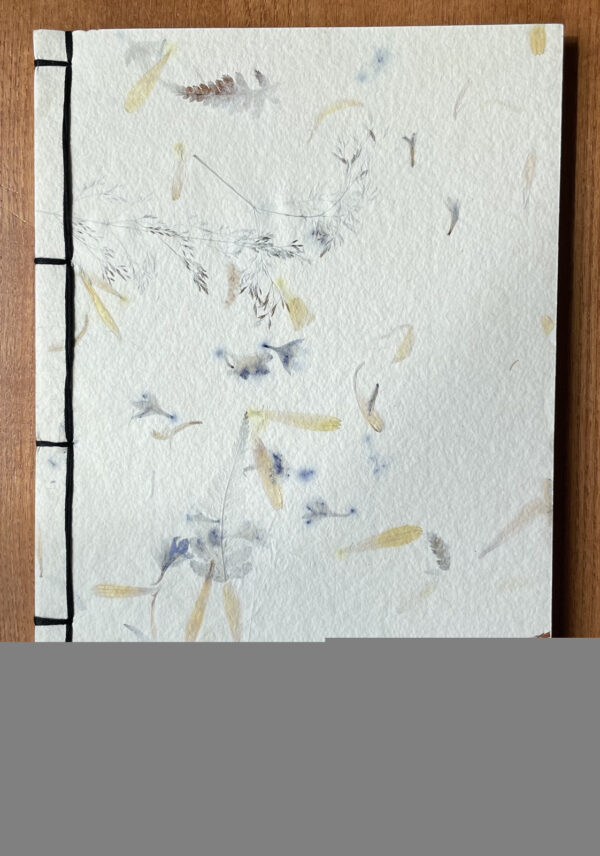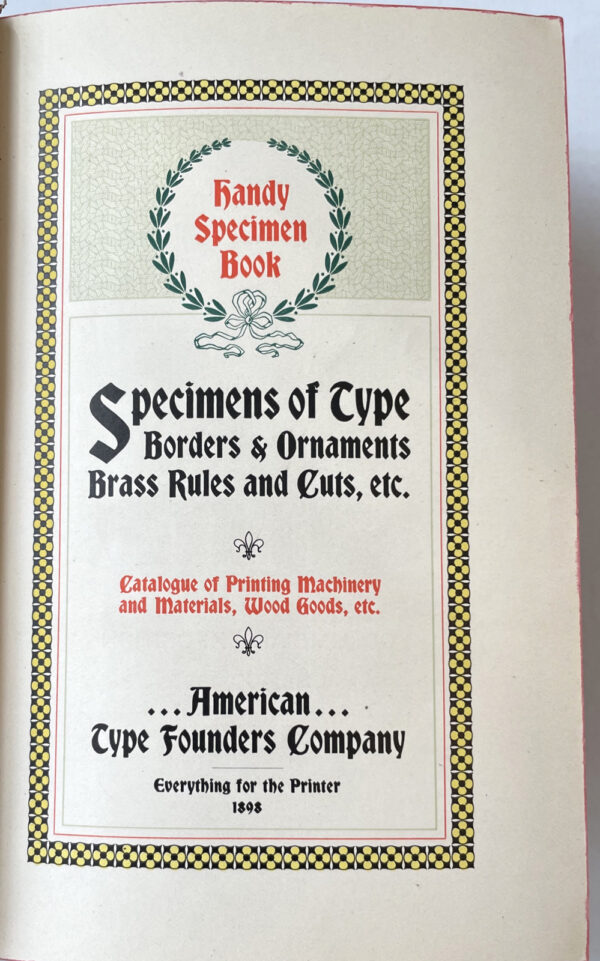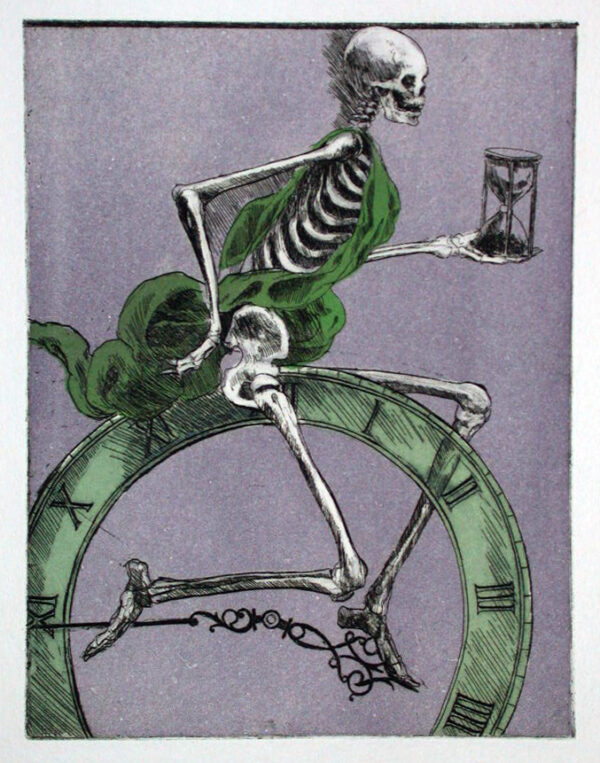
APOCALYPSE CLOCKS
Kuch, Michael A deluxe copy in 4 parts: the book, an extra suite of 13 signed etchings, original pastel of the sundial, and the original copperplate for the sundial. Folio (12 x 17). Twenty leaves including 3 black & white etchings and ten large color etchings are bracketed by two poems ("Harvest" and "Race") by Kuch. Bound by Shoshannah Wineburg in wood-veneer boards with a glass window revealing an etched clockface. That leaf, in turn, reveals the pendulum. With the third leaf we see the clock in its entirety. The book and the 3 portfolios are held in a black & red cloth tray case. A brilliant book, occasioned by the millennium. "Hourglass, sundial, gothic clock, pendulum, weights & wound spring combine with skeletal elements to produce detailed & arresting images of devices that portend the end of the world. Vibrant hues create a carnival atmosphere reminiscent of El Dia de los Muertos." No. 12 of 13 special copies, with the extra suite, pastel, & copper plate. Michael Kuch printed his etchings. Art Larson printed the letterpress text in 16 point van Dijck,- $8,050
- $8,050

Dorothy Lamour’s Life as a Phrase Book
Janaczewska, Noëlle 13 x 18. A concertina of 11 triple gate-fold pages, which unfold to about 16 feet. Designed by Mike Hudson in a variety of type faces and illustrated with his multi-colored linocuts, additionally hand colored. There is a sheet of instructions on opening/ viewing the pages. Laid into a colorful pictorial cloth box. Fine copy of a fun book. The book is a typographic rendition of Janaczewska's play, in which actress finds herself in a poem instead of a movie, and marooned in a dingy Sydney hotel. To maintain the spirit of a performance, the book has a theatrical setting. Jarvis explains "the hotel room which appears on every one of the 11 gate-fold pages, was Dorothy's stage. Onto this stage various scenarios obliquely suggested by the text were introduced . a chessboard, a maze, a giant pineapple, a clapperboard and an overweight Ronald McDonald." Production required two years. Jadwiga Jarvis, the printer, wrote that the book "will stand as a testimony to what can be achieved by a private press -- providing its proprietors are on a suicide mission." No. 20 of 30 signed copies. The Wayzgoose Press (1985 - 2021) of Michael Hudson and Jadwiga Jarvis was "a fiercely independent, reclusive private press operating from the depths of Katoomba in the Blue Mountains of New South Wales, and its output was extraordinary by anyone's standards. They combined their individual professional design skills with techniques such as handset letterpress, wood engraving, linocut, photography, craft bookbinding and calligraphy.- $8,050
- $8,050
BY A VOTE OF CONGRESS
Adams, John 7 x 10. 37 pages, large folding facsimile of Adams' letter is tipped in. Quarter red leather & marbled boards. Fine with prospectus. One of 145 copies. The book is handset in Stephenson-Blake's Caslon types that were cast from matrices made from the original punches cut by William Caslon in the early eighteenth century. A sprinkling of period printer's ornaments adds spice to the mix. Printed in two colors throughout, the book is illustrated with a frontispiece of John Adams from a period engraving based on a painting by John Singleton Copley. Also included are reproductions of an original two pence newspaper stamp tax, Franklin's now famous "Join or Die" political cartoon, and the four coffins device that identifies the victims of the Boston Massacre.- $115
- $115

FALLING TO EARTH
Double Elephant Press. Kuch, Michael No. 3 of 6 "Making Copies" housed in 4 steel-walled cases. 11 1/2 x 15. *The book of 42 leaves: 14 poems printed letterpress and 21 etchings in color and b&w. Binding materials & colors suggest the former World Trade Towers. * The 14 poems written out by Kuch on handmade paper, signed. * Complete set of 21 preparatory monotypes, signed. * Complete set of dry points, signed. * Complete set of etched states, signed * Two original copperplates. One is the final etching in the book, "Vade in pace" -- 4 elephants saluting a departing parachute, with turtle in foregorund. * A watercolored sketch of this etching * A large, finished watercolor of the etching. Falling to Earth is an artist's and poet's reaction to the terrifying and tragic collapse of the World Trade Center Towers and to the ensuing bombing campaign. The book's imagery uses the metaphor of falling to look at the human and spiritual costs of violence. Mythological & biblical narratives are evoked in a modern framework that may give perspective to raw, recent events. Icaraus, Jacob's ladder, & parachuting Christs descend in our new millennium. The poems and etchings are frequented by angels providing vantage from above. In Falling to Earth Michael Kuch "hopes to unfold a kind of topographical map of healing." The edition is 100 copies (with 10 hors commerce). Text and binding papers were made in New York by Carriage House Papers and Dieu Donné Papermill; text printed by Art Larson in 14 point Emerson. Bound by Shoshannah Wineburg and Barry Spence.- $6,900
- $6,900
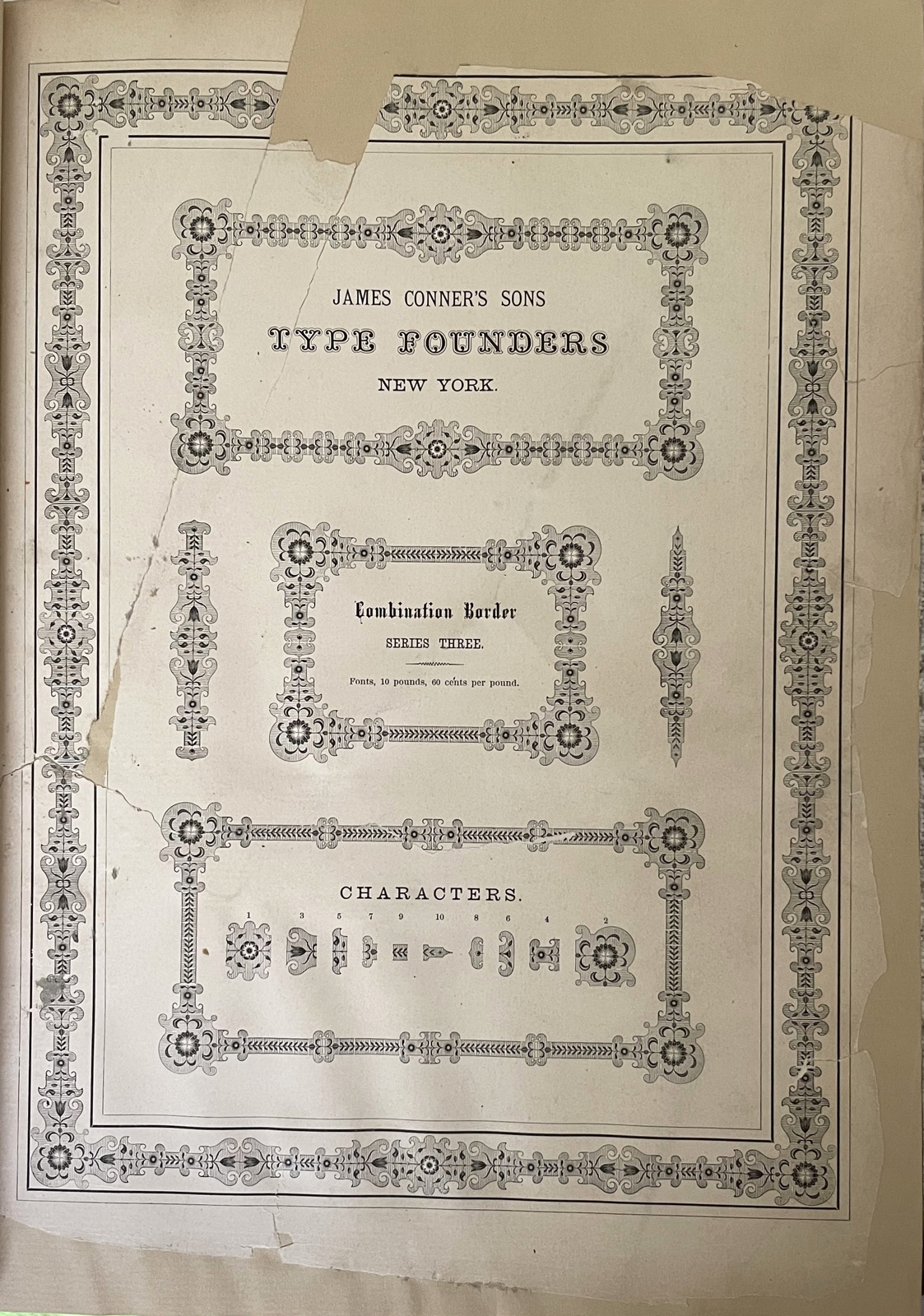
(A SPECIMEN OF ORNAMENTAL MATERIAL & CUTS)
Connor's, James Sons Typefounders. 9 3/4 x 12 3/4. About 195 leaves printed on one side (rectos) only. No title page. The first 78 leaves are not numbered. They display combination borders. There is some color printing. Several leaves are chipped or clipped and are mounted one leaf has been removed. Electrocuts comprise the second part. It is numbered 1 to 123 but is missing at least 7 leaves. It also has chips & tears. Internal condition is "good." Rebound in black cloth & marbled endpapers.- $575
- $575
American Specimen Book of Type Styles
American Type Founders 7 3/4 x 10 3/4. xvi, 17-868 pages. Red cloth titled in black on cover. Near fine. ATF's largest specimen and the largest foundry specimen ever produced in this country -- dubbed "Big Red' on issue. Sooo big, that the office copy was bound in two volumes with a total of 1301 pages. Only Volume One is present here. The pages NOT present are: exotic types, decorative material, and printing machinery.- $288
- $288
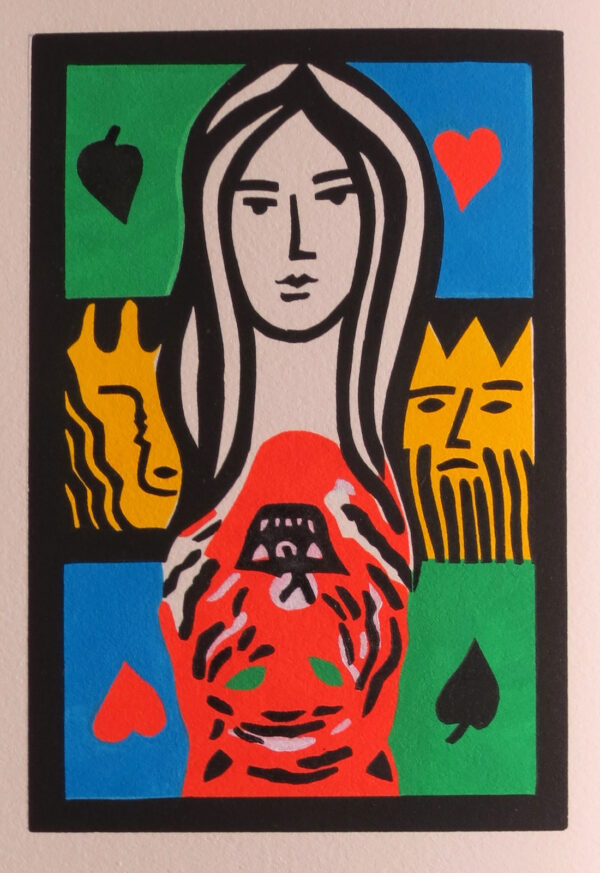
The Lady or the Tiger
Stockton, Frank L. 6 x 9. Approx 28 pages. Two pochoir frontispieces in six colors, & a dozen small, single color drawings by Walter Bachinski of the Shanty Bay Press. Bound tete-beche in quarter cloth, slipcase. Fine. These are two stories about "ambiguity and living in a society ruled by arbitrary justice." No. 17 of 30 copies printed letterpress in Weiss and American Uncial on handmade Batcham Green paper. Signed by the artist.- $920
- $920
THE OFFICINA BODONI, AN ACCOUNT OF THE WORK OF A HAND PRESS 1923-1977
Mardersteig, Giovanni 8 x 12. lix, 286, (1) pages. Illustrated. Quarter morocco & cloth, morocco-edged cloth slipcase. A fine set with prospectus. No. 98 of 99 deluxe copies with the second volume containing 10 original 4-page leaves (including Ovid's Amores on vellum, Holy Gospels with woodcuts, and Aesope with 2 hand colored illustrations). Printed at the Stamperia Valdonega. Definitive bibliography of this fine press, with many plates, chapters on the type faces and devices used at the press, and seven indices.- $1,144
- $1,144
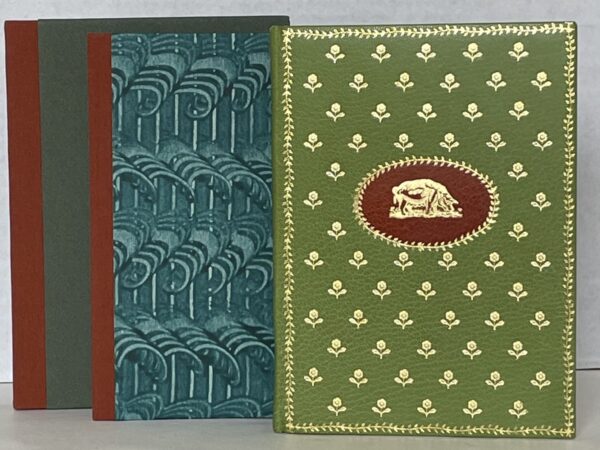
Seasons from Nicholas Breton’s ‘The Twelve Moneths’ written in 1626
Connors, Sandy 5 1/2 x 7. (14) pages. Full green morocco gold tooled with flowers & leaves; brown morocco insert with gilt pig on cover; marbled endpapers. A separate portfolio holds a printing of the 4 seasonal engravings, colored by the artists, signed & numbered. Both fine in slipcase. One of 5 special sets in this fine binding by Christopher Shaw. The edition was 20 special copies and 45 regular, uncolored copies in boards. Only 5 specials were for sale, the remaining specials were for the binder.- $518
- $518

Matrix, A Review for Printers and Bibliophiles
Randle, John and Rosalind A mixed set of 38 volumes: Volumes 1- 36: Matrix 1 1985 reprint of 1981 Matrix 2 wraps regular 1982 Matrix 2 reprint deluxe 1993 Matrix 3 to 30 are all deluxe versions 1983-2012 Matrix 31 to 36 wraps regular 2012-2020 Plus deluxe Index for Matrix I to XXI. Except for Volume 2, the first 30 volumes are the deluxe issues with extra specimens, bound in morocco & marbled boards, slipcased. Beginning with Vol. 7 all the deluxe issues came with a separate portfolio of specimens. All are in fine condition. A treasure-trove of interesting material on private presses, wood engraving, type design, papermaking & decorated papers, letterpress printing, richly illustrated with numerous inserts and specimens. "Matrix is by now so well established," wrote Sebastian Carter in 2012, "that there is a danger that we may take it for granted. People in the future will look back in amazement at its riches. The majority of its illustrations are not reproductions, but the real thing. It is like visiting a group of collectors who keep bringing treasures out of drawers for our inspection --which we are then allowed to keep." See Parenthesis 44, pages 18-25.- $17,250
- $17,250
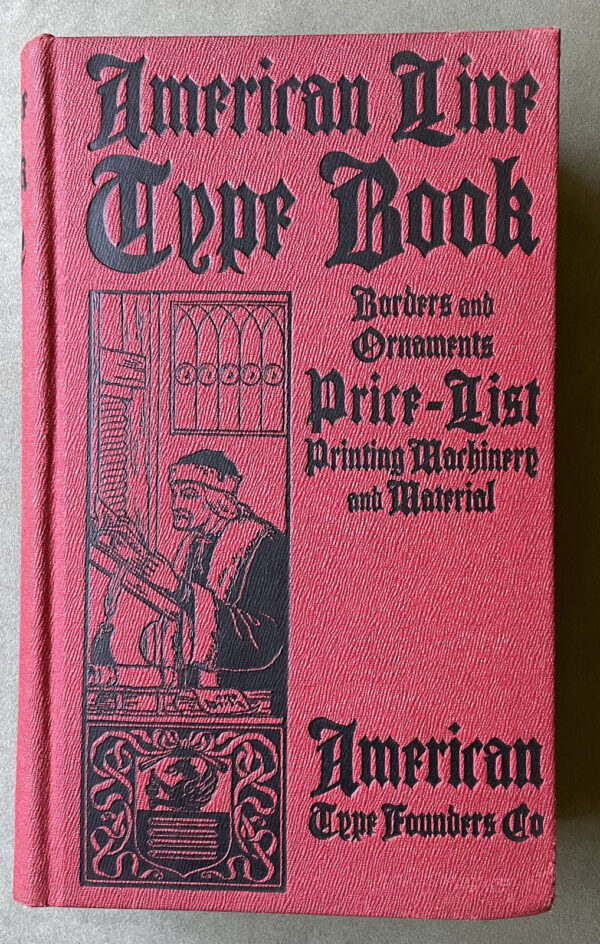
American Line Type Book
American Type Founders Co 6 x 10. xxx, 1181 pages plus 34 subscripted pages; with four pagination gaps as issued. Tipped in errata. Laid in are 2 order forms. Collated complete. Red cloth printed in black.A beautiful, fine copy. Extensive specimen with large sections of border and decorative material (about a third of the specimen) with much "arts & Crafts" material (Bradley, Hapgood, Roycroft). With wood type and printing equipment. According to Annenberg, there were 4 versions of this specimen, differing only in the brass rule section.- $575
- $575
Caprices & Grotesques
Gehenna Press 8 x 11. 16 leaves on various colors of Fabriano & Japanese papers. There are 17 line drawings. Wraps. Fine in slightly chipped slipcase. One of 500 copies, this specially signed by Leonard Baskin. Some of the drawings are titled (e.g. "after Leonrdo," "The torment of Albrecht Durer," "The torment of Michelangelo"). These are printed in red in Cancellaresca type.- $316
- $316
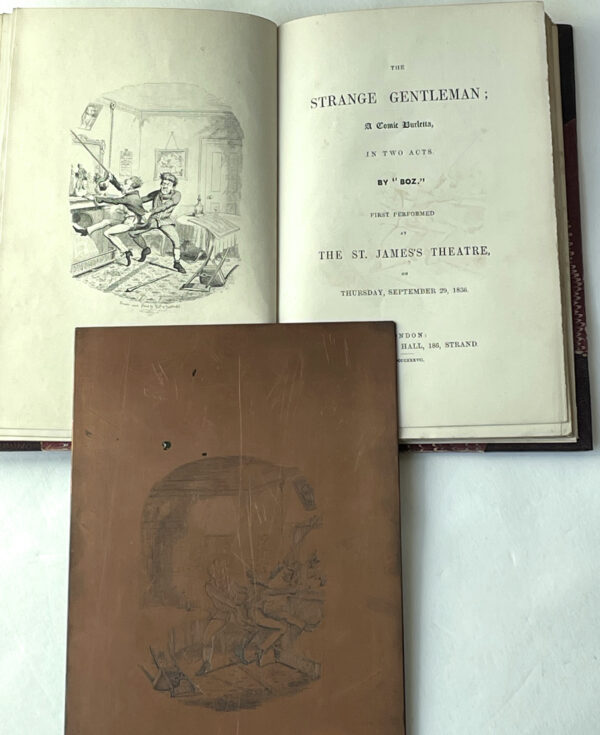
The Strange Gentleman
Dickens, Charles 5 x 7 1/2. Frontis, 46 pages, (1) ad. Original printed wraps bound into half morocco & marbled boards, matching endpapers. Bookplate of Vivian L. Henderson. WITH Pailthorpe's original copper-engraved plate (canceled) for the frontispiece. The plate measures 9 x 5., with image is 4 x 3. The plate has been canceled. The book is in very good+ condition. According to Eckel, copies of the 1871 edition with the frontis are particularly rare, as the illustration was evidently drawn and etched by the artist after the book was published. The etching was sold separately. The Morgan Library has Pailthorpe's watercolor drawing for this frontispiece.- $1,380
- $1,380

AMERICAN SPECIMEN BOOK OF TYPE STYLES
American Type Founders 7 3/4 x 10 3/4. xvi,17-1301 pages and 10 sectional titles. Red cloth stamped in black, edges dyed red. Upper tips lightly bumped; separation between pages 1278 & 1279. A very good copy. ATF's largest specimen and the largest foundry specimen ever produced in this country -- dubbed "Big Red' on issue. Many pages printed in color, displaying use of types, borders, & ornaments;, with over 100 pages of decorative material. There's some exotic (Hebrew, Greek, Gaelic, Esperasnto) and music type; wood type & borders. Pages 1153 to the end illustrate printing machinery and furniture.
CANCELLERESCA BASTARDA DISPLAYED
Gehenna Press 5 x 6 1/4. 16 leaves printed rectos only. Marbled paper (by Peter Franck) over boards, title label on upper cover. Fine. With an autograph signed letter from Baskin, apologizing for having no deluxe copies left, and sending this copy. Printed in Van Krimpen's Cancelleresca Bastarda in three sizes, in a variety of colors (one page has 7 colors) on pre-WW II Amalfi from Bruce Rogers. The 11 mottoes and maxims are translated into English on the last page. This glorious little production is the first of three books in which Baskin focused his extraordinary skills in selection and layout of type, ornament, and color. No. 41 of 100 signed copies.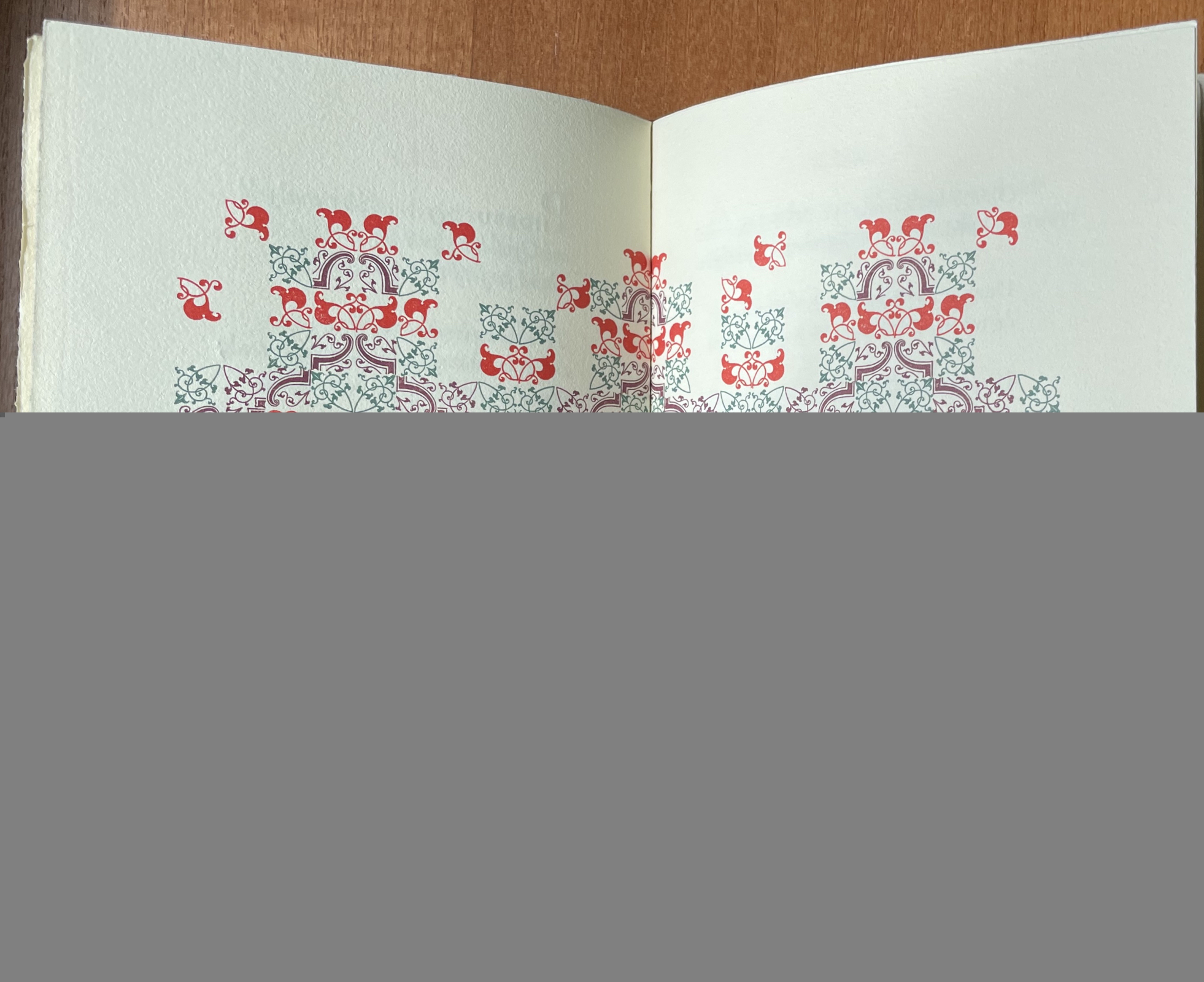
Il Giardino d’Amore. The Garden of Love
Aliquando Press The Italian poems are printed in roman type and face the English translations in italic type. Four seasonal gardens illustrated the text. Rueter created these double-spread gardens from printers' flowers in various color combinations. Bound in leaf-patterned cloth , paper spine label, sunny yellow endpapers. Fine copy of a very satisfying book. In his 5-page introduction Will Rueter, discusses the madrigal. One of 45 copies.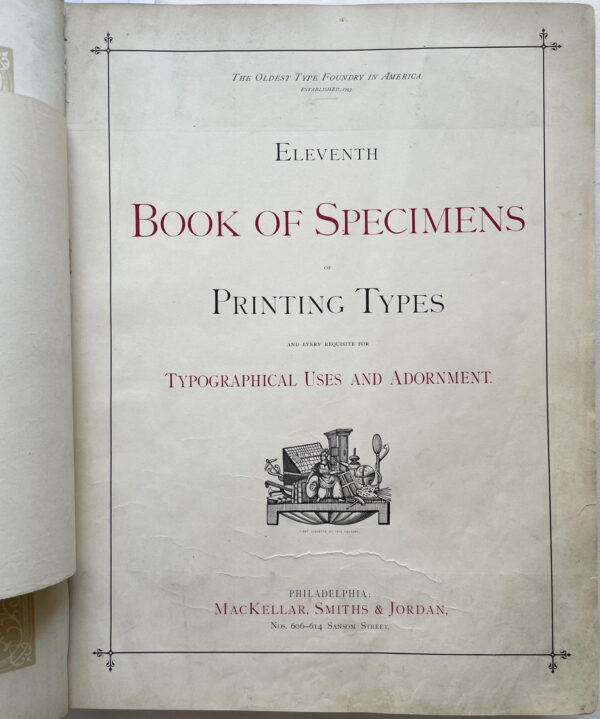
Eleventh Book of Specimens of Printing Types
MacKellar, Smiths & Jordan 9 3/4 x 12 3/4. Frontis, notice about mutilation & prices tipped in, title, Preface, Table of Contents (2 pages), leaves printed mostly on rectos are numbered 9-905. There are numerous gaps in pagination, so the actual leaf count would be less. Despite the notice, one tiny letter and one large pointing hand have been cut out. There is no price list present. Bound by Brewer-Cantelmo Co. (mid c20) in black cloth, gilt lettering worn away. Edges rubbed, paper separation over hinges but covers on firmly. This book bears the printerly soil of its time in a printing shop. The page margins are toned, there are some small tears. Overall condition is very good. MacKellar boasted "the largest variety in the world of Original Productions, unequaled for novelty, beauty, and skillful adaptedness for rare typographical effects. There are some 100 leaves of ornamented/ display types. First issued in 1878, this is the largest MacKellar specimen. The Eleventh Specimen was reissued periodically. The three copies on OCLC are all the second issue. Rochester's is dated 1889; Columbia and Cornell are dated 1885. All are paged 8-943, but give a count of 504 leaves. Cornell's copy is digitized on line. All other MacKellar specimens after 1878 are either "Compact" or "Handy." This is the only "Greater." The MacKellar specimens, all rare on the market, are among the finest produced in the 19th century. They are noteworthy not only for the foundry's line of faces and decorative material, but also for the pithy and humorous settings that display the type.
